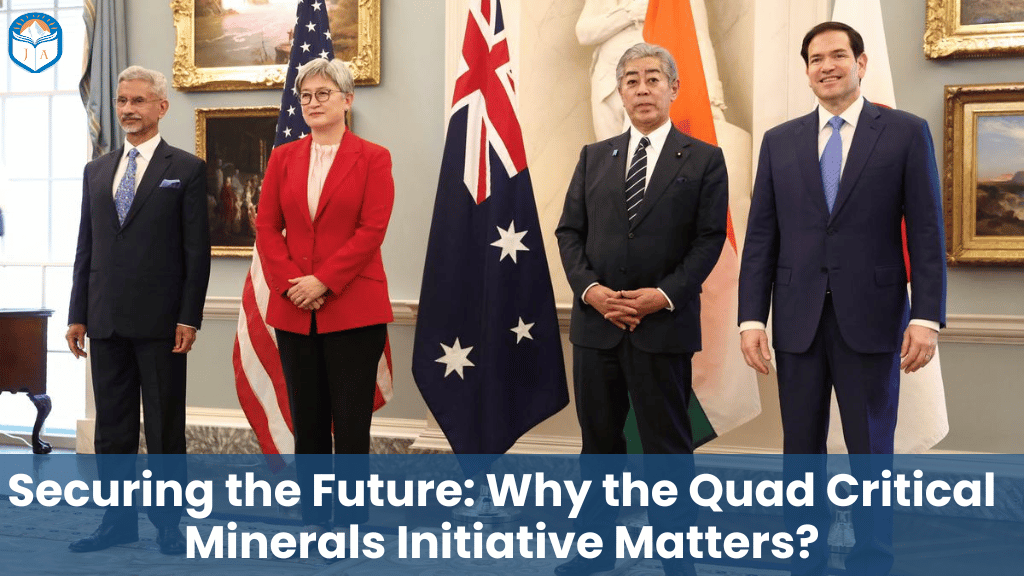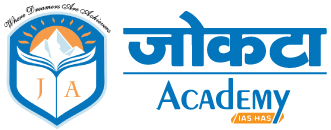Quad Critical Minerals Initiative: A Strategic Move Towards Secure and Sustainable Supply Chains
The recently launched Quad Critical Minerals Initiative during the second Quad Foreign Ministers’ meeting in Washington, DC marks a decisive step in ensuring economic security, supply chain resilience, and global technological advancement. As the world races towards a clean energy future, the demand for critical minerals—the building blocks of renewable technologies—is rising exponentially. Recognising this urgency, the Quad alliance (India, USA, Japan, and Australia) has jointly committed to securing and diversifying critical minerals supply chains.

Why is it in the News?
The Quad Foreign Ministers’ meeting not only addressed global security concerns, such as condemning the Pahalgam terror attack, but also unveiled key strategic initiatives. These include:
- Quad Critical Minerals Initiative
- Quad Indo-Pacific Logistics Network Field Training Exercise
- Quad Ports of the Future Partnership (to be launched in Mumbai)
The highlight, however, was the collaborative push for critical minerals cooperation, which is rapidly becoming a geoeconomic imperative.
Why Critical Minerals Matter?
From solar panels, electric vehicles, wind turbines, semiconductors, to advanced batteries—critical minerals like lithium, cobalt, graphite, rare earths, and nickel are indispensable. They form the core of technologies that drive the energy transition and support digital transformation.
Without these minerals, clean energy goals such as India’s target of 500 GW non-fossil fuel-based installed capacity by 2030 and Net Zero by 2070, are unattainable.
Dependence on China for Critical Minerals
One of the biggest global risks in the critical minerals domain is the overdependence on China for both mining and processing:
- China accounts for two-thirds of global rare earths mining.
- In processing, China holds a 66% share across critical minerals, including copper and aluminium.
- For rare earth elements, over 90% of global processing occurs in China.
- It also holds:
- 35% share in nickel refining
- 50–70% of global lithium and cobalt processing
- 90% of rare earth element refining, according to the International Energy Agency (IEA)
China’s monopoly gives it the power to disrupt the global EV industry, renewable energy deployment, and high-tech manufacturing by simply restricting critical mineral exports.
Global Reserves Snapshot (US Geological Survey):
| Country | Rare Earth Reserves (million metric tons) |
|---|---|
| China | 44.0 |
| Brazil | 21.0 |
| India | 6.9 |
| Australia | 5.7 |
| Russia | 3.8 |
| Vietnam | 3.5 |
This reserve data shows that countries like India, Brazil, Australia, and Vietnam must be leveraged through partnerships to reduce the world’s critical mineral vulnerability to China.
What is the Quad Critical Minerals Initiative?
The initiative is a multilateral effort to:
- Secure and diversify global supply chains of critical minerals.
- Counter over-reliance on any single country, particularly China.
- Enhance economic and strategic autonomy of member nations.
- Promote collaboration in sustainable mining, processing, technology sharing, and regulatory harmonization.
“Reliance on any one country for processing and refining critical minerals exposes our industries to economic coercion, price manipulation, and supply chain disruptions.”
India’s Role and the National Critical Minerals Mission
India is not merely a participant but a key driver of this transition.
National Critical Minerals Mission (NCMM):
- Launched in January 2025 with a ₹16,300 crore outlay.
- Aims to reduce import dependence, particularly on China.
- Fast-tracks exploration and mining approval processes.
- Identified 30 key critical minerals including lithium, cobalt, graphite, tin, and nickel.
- Supports domestic value chains and aligns with India’s Net Zero by 2070 commitment.
According to the 2024 IEEFA report:
- India’s demand for critical minerals will double by 2030.
- Domestic production capacity may take over a decade to mature.
- Strategic sourcing from countries like Brazil, Tanzania, Mozambique, and Madagascar is vital.
Strategic and Geopolitical Implications
The Quad Critical Minerals Initiative aligns with global goals to:
- Promote supply chain transparency
- Reduce exposure to geopolitical blackmail
- Accelerate the clean energy transition
- Ensure economic and national security
By integrating with global alliances like the Minerals Security Partnership (MSP), the Quad can offer a sustainable, secure, and diversified alternative to China’s mineral monopoly.
Conclusion: A Geostrategic Necessity
The Quad Critical Minerals Initiative is more than an economic collaboration—it is a geostrategic response to growing vulnerabilities in the global supply chain. It aims to empower nations with the tools to meet climate goals, boost high-tech manufacturing, and safeguard against coercive monopolies.
For India, this initiative complements the National Critical Minerals Mission, bolsters its energy security, and establishes it as a responsible global player in the green economy.
With the increasing importance of current affairs, environmental issues, and global geopolitics in the civil services syllabus, staying updated has become more critical than ever. For comprehensive preparation, expert mentorship, and well-structured guidance, Jokta Academy in Chandigarh is regarded as one of the top institutes for HPAS and IAS coaching. The academy offers both offline classroom programmes in Chandigarh and online live sessions, making quality education accessible to aspirants across India. Known for its result-oriented approach, focus on answer writing, and in-depth current affairs analysis, Jokta Academy equips students with everything they need to crack the toughest exams with confidence.
To learn more, join the Jokta Academy’s specialized HPAS & IAS mentorship programmes – both online and offline (Chandigarh).
Visit: https://joktacademy.com
Stay ahead with updated insights, curated notes, and expert guidance for your civil services journey.

